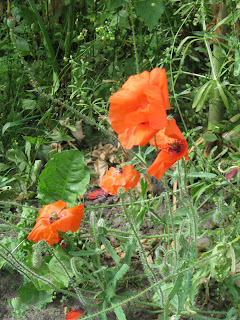
As the lush green of June gave way to July, high summer this year brought days of hot sunshine and very little rain. Roses and delphiniums finished their displays and the brightest flowers were often those of self-set annuals, or of wild flowers allowed to stay where they had grown.

Scarlet flashes of poppy petals ......
 ...and the soft, pale mauve of a mallow that no one has planted.
...and the soft, pale mauve of a mallow that no one has planted.As the month passed, we left a patch of lawn to grow unmowed. A sea of white clover blossomed first, and was alive with honey bees and bumble bees. Later came the butter yellow Birds Foot Trefoil......

..a patch of purple Self Heal.....

.....and the tall white discs of Yarrow flowers stood out above the drying grass and clover,

....while Scarlet Pimpernel opened its flowers to the sun.

Down in the vegetable garden, the green of plants watered each evening contrasted with baked , brown pasture in the fields beyond. In among the beans and the courgettes , beautiful poppies had seeded themselves and enticed the bees to pollinate the plants.

A single Love in a Mist plant appeared with its delicate leaf fronds and deep blue flowers beside shining green leaves of spinach and Swiss Chard.

More poppies among the beans, with single petals.....
 ....and some with ruffled pom pom flowers like layers of crinoline on a long-ago dancing dress.
....and some with ruffled pom pom flowers like layers of crinoline on a long-ago dancing dress.
In a border where the roses were almost over, a tall pink lily blossomed for days in the heat of the sun. The bulb was a birthday present from an old friend. Three years on, it still blooms throughout July.


Rosa Kiftsgate has finished flowering now. For less than two weeks, it flourished and tumbled over an old wooden fence and was humming with bees through all the daylight hours.


A new plant, brought back from a June visit to the wonderful gardens at Sissinghurst Castle in the Weald of Kent. Nicandra physalodes alba flowers in Vita Sackville-West`s White Garden there. An annual that grows from tiny seedling to a lush plant over a metre high, its pure white flowers last for just one day and then form seed pods to harvest and keep safe, to plant again in spring.


As the month passed by, we noticed more and more young rabbits venturing into the garden. As the field grasses withered and died, they needed garden grass and water. I watched this one feeding on the lawn before it hopped into a border to sample more interesting leaves and flowers.



7 comments:
What a charming post DW and such photographs too. We don't seem to have scarlet pimpernel up here - it was lovely to see it.
Our wild flowers - and much in the garden - are already going to see - Autumn sets in early up here.
A very interesting post. I am about to start a meadow on a section of lawn that is only used by the wildlife. I just hope it turns out as pretty as yours.
I'm planning a little wildlife corner in my hoped-for garden too. Poppies amongst the beans raise eyebrows on my allotment though!
I am most envious of the poppies--I have seed of some heirloom varieties which didn't get sown before the hot weather came on. I"m thinking I can scatter them this fall and have poppies early next spring. My hope is that they will "cross" eventually and create beautful shaggy, colorful offspring--I enjoy volunteer, nearly wild plants.
We too, have a rabbit--a small one, so I assume it has "friends and relations."
Thank you all. We have had a few hours of rain today so the garden is much fresher and more alive.
Rachel - I can imagine that the other allotment gardeners can be quite formal about what grows where. It will be lovely when you can create your own wild area in your new garden. I do weed out the usual weeds but can never have the heart to pull up a poppy or a sunflower.
A wonderful array of flowers. I have loved the lowly scarlet pimpernel for many years -- also because I liked the books as a child. The lily is absolutely gorgeous.
Gosh still plenty of lovely colour. Like you, I tend to let things live where they just "appeared" (except several walnut trees in the borders, which the squirels gave me!).
Post a Comment